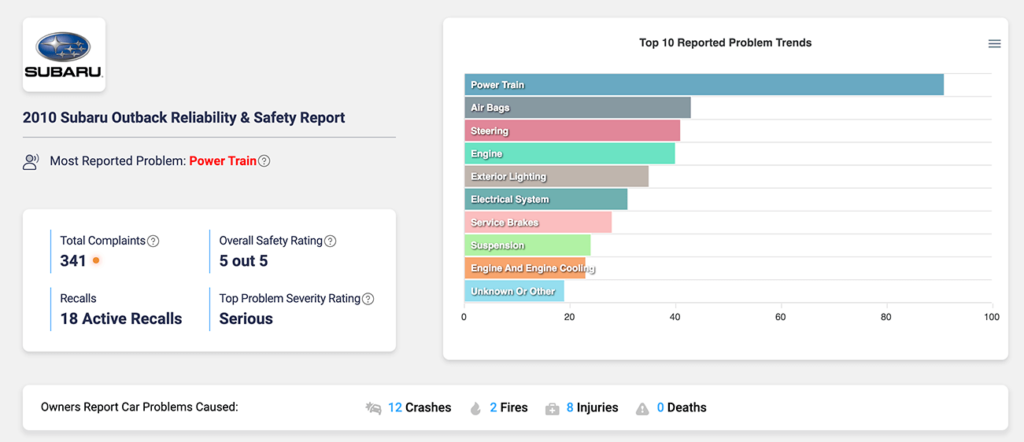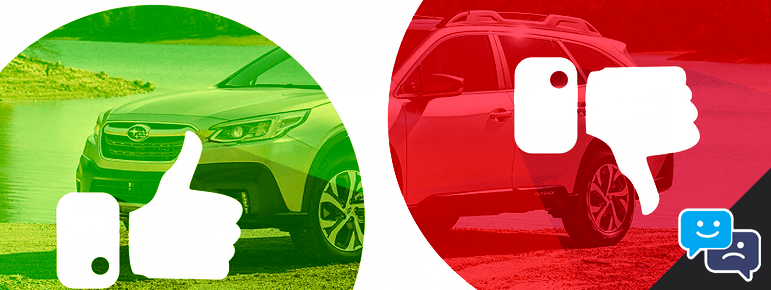The Subaru Outback has a reputation for dependability on the road, but not all models of the Outback live up to the Japanese brand’s stellar reputation. Here are the Subaru Outback years to avoid.
The following Subaru Outback model years should be approached with caution: 2010, 2011, 2013, and 2015-2020. These years are known to have potential issues with excessive oil consumption, transmission problems, battery drain problems, and other mechanical issues that may lead to costly repairs.
If you are you in the market for a reliable and affordable used Subaru, the Outback is a popular choice. And for many good reasons, as it’s a clever and functional option to sedans and SUVs.
And with ample storage capacity and a higher ground clearance than typical cars, it provides sufficient off-road capability to access secluded campsites.
However, there are certain years of the Subaru Outback that have been plagued with various issues throughout the years.
In fact, there is at least a 10-year span of problematic — and sometimes downright dangerous Outback models to avoid.
Simple truth is, between 2010-2020 Outback model years, all have a varying degree of problems, some more costly than others.
In this guide we’ll take an in-depth look at which Subaru Outback model years should be avoided. It is my hope that this guide will prevent car buyers, such as yourself, from purchasing a defective Outback.
Let’s get into this!
Why Avoid the 2010 Subaru Outback?
Starting off, the 4th generation of Subarus, 2010 was a promising year. However, the 2010 Subaru is poorly ranked due to a range of issues.
Issues such as head gasket failure, torque converter issues, electrical problems, suspension noise and wear, and rust and corrosion to the body of the car.
Head gaskets failing evidently don’t spell good news. The torque converter issue is one that car owners shouldn’t take lightly, either.
Simply truth is, after carefully reviewing complaints for this model year, the torque converter issue can be down right dangerous.
Electrical problems can be the cherry on the cake when it comes to numerous problems happening at once.
With that said, tread carefully if considering a 2010 Subaru Outback.

Safety Concerns
Most importantly, these early model Outbacks suffered from defective airbag inflators. However, Subaru did eventually issue a recall for the front passenger side airbag.
If you are considering this model year Subaru Outback, be sure to check that the following NHTSA recalls have been performed for the airbag problem: 19V007000, 19V009000, 19V008000, 20V001000, 20V003000, 20V002000, 18V013000, 18V012000, 17V014000, and 16V358000.
Other Customer Satisfaction Issues
Headlights, corrosion on the rear four-way brake joint connector, and subframe rust are also commonly reported issues. Signaling an expensive maintenance schedule for this Subaru model year.
View the full list of reliability and safety trends for this vehicle.
Why Avoid the 2011 Subaru Outback?
Unfortunately, the 2011 Outback model didn’t fare much better than the previous model year. The transmissions on these vehicles still was an issue.
In fact, transmission problems comprised the majority of 2011 Subaru Outback complaints. Owners experienced delayed shifting or jerking while shifting.
If you do decide to purchase this model year Outback, make sure you check the transmission, paying close attention to how it shifts.
Other Customer Satisfaction Issues
Additionally, suspension issues were also reported by some, including noise or vibration while driving or uneven tire wear. A few owners also experienced electrical problems, such as warning lights appearing on the dashboard or malfunctioning electronics.
View the full list of reliability and safety trends for this vehicle.
Why Avoid the 2013 Subaru Outback?
2013 is widely considered Subaru’s worst year, with a class action lawsuit being brought against Subaru for the high oil consumption.
The lawsuit alleged that the company knowingly sold engines with bad piston rings, allowing oil to enter the combustion chamber and burn off. Low oil levels can lead to engine overheating, failure, or damage.
Paired with steering and transmission issues, the 2013 Subaru was, upon release, a very frustrating and unreliable vehicle.
Subaru has compensated disgruntled customers, fortunately. But it’s still definitely worth reviewing the service history very carefully if you’re looking at a 2013 Subaru.
And since this year continues to be the worst-performing Subaru Outback vehicle to date, we recommend skipping it given other choices.
Other Customer Satisfaction Issues
Beyond the oil consumption problems, the 2013 model year also suffered from transmission problems with the CVT and windshield cracking.
View the full list of reliability and safety trends for this vehicle.
Why Avoid the 2015-2020 Subaru Outback?
The 2015-2020 Subaru has frequent reports of battery failure, causing the car not to start, especially in cold conditions. In fact, owners eventually sued Subaru over the issue.
Thankfully, a settlement was reached and those owners experiencing the dreaded “dark current” defect have received compensation.
If considering a 2015-2020 Outback, be sure to check that this recall had been made.
Other Customer Satisfaction Issues
The 2020 Subaru Outback has also starting to rack up complaints over cracking windshields.
Reports have surfaced indicating that these vehicles are equipped with subpar quality windshields, raising serious concerns about the craftsmanship of this model year.
Unfortunately, the windshields cracking without impact seems to be a widespread defect across the 2020 Subaru Outback model years.
Why Avoid the 2021-2022 Subaru Outback?
Sad news: windshield issues continue to trouble the 2021and 2022 Outbacks. Random cracks spontaneously appearing overnight are among the woes detailed by owners.
And, adding insult to injury, some report that hitting a pothole going highway speeds has caused sudden crack in their windshields.
Some Outback owners have even opted for a windshield protectant film called carbon steel film windshield protection.
So what is Carbon Steel windshield film? It’s a clear film that goes over the outside of the windshield, forming a chemical bond with the silica present in glass. This fills up the tiny bumps and crevices on the glass surface, creating a very thin but strong barrier.
This film helps to seal the glass surface and improves visibility while also protecting the glass from getting damaged by tough environmental conditions.
However, the jury is still out on if this film helps solve the Outback’s notorious sudden windshield crack problems.
Final Thoughts
To sum it up, the Subaru Outback offers reliable and affordable performance, with plenty of space and off-road capability. However, prospective buyers should take note that not all years of the Outback are created equal.
The 2010, 2011, 2013, and 2015-2020 model years have been known to have problems ranging from excessive oil consumption to transmission issues and battery drain problems. Then there is, of course the mysterious windshield cracking problems.
Knowing this information can help you make an informed buying decision when hunting for used vehicles.
And if you decide to purchase a model year Outback listed in this guide, just keep a close eye on these reported problems.
As always, be sure to thoroughly research any car you may be interested in before making a purchase. If done right, the Subaru Outback might just turn out to be the perfect car for you!

Managing Editor
Christopher is an automotive technical writer. When he’s not at the local autocross event, he can often be found working on one of his cars. Specializes in automotive class action law, industry trends, and automotive maintenance. Email me direct, or learn more about us

